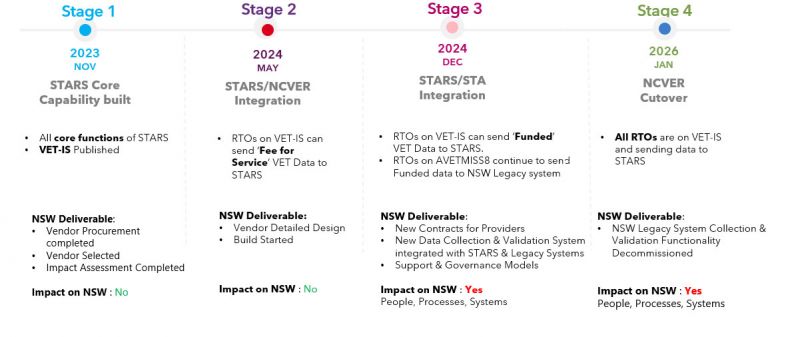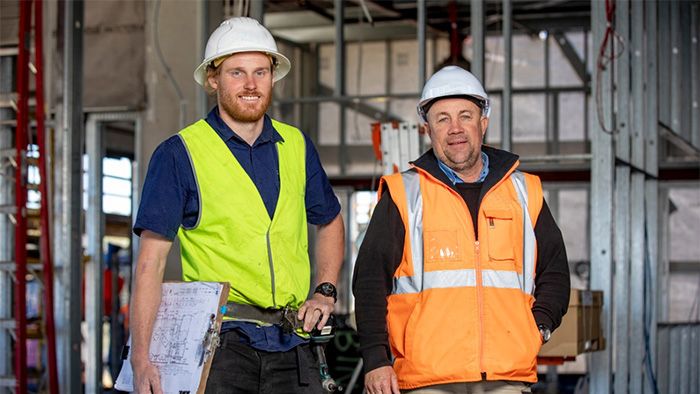The Vocational Education and Training (VET) Data Streamlining (VDS) program focuses on improvements to collecting and using VET activity data.
The VDS vision
The VET Data Streamlining program aims to modernise how student training activity data is collected, managed and utilised across the sector. The program has a focus on improving outcomes at a national level via:
- a VET Information Standard that better reflects the sectors information needs
- wider adoption of modern technology that enables better data faster
- simpler and more timely validation and anytime submission of VET activity data.
The changes proposed to realise the vision
To achieve this vision, the program aims to introduce:
- a VET Information Standard designed around an event-based reporting structure
- a new Student and Training Activity Reporting System (STARS) that can connect to Student Management Systems (SMS)
- an updated VET data governance framework covering policy, regulation and legislation.
The benefits delivered with successful change
Once the program is delivered, students and training providers can expect:
- more timely updates of student transcripts and information about upcoming courses
- less time spent correcting errors with only individual records being returned for correction in near real time, rather than whole submissions
- more flexibility to submit data at a time that is convenient to providers
- increased reporting efficiency through a consolidated and nationally consistent VET Information Standard that includes state and territory data elements.
The VET Data Streamlining (VDS) project is intended to improve the way VET training activity data is collected and used across the sector.
Better data, faster means the VET sector will be:
- more resilient to future challenges armed with quality, up-to-date data
- supported by modern systems
- able to quickly develop new products and services in response to emerging skill requirements, supporting job creation and economic growth
- well positioned to be a global leader by enabling faster evidence-based decision making.
What success looks like
Objective: The program objective is to ensure that Australia’s VET education sector remains:
- globally competitive
- resilient to emerging challenges
- well positioned to harness the power of information to support economic growth and improved outcomes for Australia and its citizens.
Success criteria: The VDS program will be successful when the VET sector is better supported with quality information and data, enabled by contemporary technology.
In practice this means:
- a nationally consistent data collection and management system which has been established, integrated and utilised by the majority of the VET sector
- the new VET Information Standard is widely adopted and incorporated into business-as-usual practices
- up-to-date, high-quality data is used to inform better decision making for administrators, providers and students
- the program supports the sector to be ‘future ready’, resilient and responsive to emerging challenges
- the overall regulatory and administrative burden across the sector has not increased, due to more efficient business practices
- the regulatory and administrative burden has decreased from current levels in the long term.
More information will be available as the timing of VET Data Streamlining becomes clearer. A transition period will be available to support states and territories, SMS vendors and training providers as they adopt the new VET Information Standard and system changes.
Progress and next steps

Stage 1: By November 2023 it is expected that the STARS core capability will be built. At this time it is also expected that the new VET Information Standard will have been published.
Stage 2: By May 2024 it is expected that an integration between STARS and NCVER will be complete and allow ‘Fee-for-service’ RTOs to submit via STARS
Stage 3: By December 2024 it is expected that an integration between STARS and TSNSW will be complete and allow ‘Funded’ RTOs to submit via STARS
Stage 4: By January 2026 all RTOs are expected to have transitioned away from AVETMISS 8 and are submitting data via STARS
NCVER is leading the development of the new VET Information Standard on behalf of the Australian, state and territory governments, and regulators. Once approved, the new standard will initially replace the AVETMISS VET Provider 8.0 Collection and is proposed to include some new and modified reportable data elements.
Implementation of the VET Information Standard will require enabling new technology. The Australian Government is currently leading this work with state and territory governments, regulators and the NCVER to ensure that existing SMSs and TSNSW applications can readily integrate with the new Student Training Activity Reporting System (STARS).
More information will be available once confirmed.
World-leading education and training must be supported by quality information and data, enabled by contemporary technology
A sector in need of data streamlining
The current VET data reporting arrangements and submission systems are generally unnecessarily demanding, multi-layered, and complex. Consumers of VET data want more up to date student activity information, high quality data and a shared approach to information, supporting improved outcomes for the sector.
The impact of global forces, such as the COVID-19 pandemic, have demonstrated the importance of responding quickly and flexibly to emerging issues. If the VET sector is to meet future challenges head on, access to high-quality, meaningful, and timely information will be a key enabler of this.
The Australian Government, in partnership with the National Centre for Vocational Education Research (NCVER), state and territory governments and sector regulators are working to deliver the VET Data Streamlining program.
We aim is to ensure that the VET sector is well positioned to manage future challenges, armed with high-quality, timely information.
Why change is important
In recent years, the needs of students, training providers, and decision-making entities in the Vocational Education and Training (VET) sector have changed, while data management processes have often lagged. For many, the current reporting arrangements and submission systems can be unnecessarily demanding, multi-layered and complex.
The future viability of the VET sector will rely partly on its ability to:
- respond rapidly to changing skill needs
- facilitate upskilling and reskilling
- contribute to life-long learning.
The VET Data Streamlining program has been established to help address this priority. It will ensure the sector can harness the power of high-quality, timely data to address future and emerging challenges from a position of strength.
The path to reform
In July 2020, the Australian, state, and territory governments agreed to the Heads of Agreement for Skills Reform. It committed to wide-ranging reform of the VET sector to support Australia’s long-term economic wellbeing and recovery from COVID-19.
The VET Data Streamlining program is part of this Skills Reform. The reforms stem from recommendations of the Joyce Review and Braithwaite Review.
A consistent theme in VET data reporting arrangements is that the VET data reporting system is overdue for reform. Review of RTO Data Reporting Arrangements report, places an administration burden on data submitters. The technology used for data validation and submission is also out of date. It involves manual processes that lead to inaccuracies and long lag times.
World-leading education and training need to be supported by quality information and data, in turn, supported by contemporary technology.
NOUS Report, 17 January 2018
VET Data Streamlining is a joint initiative
The Australian, state and territory governments, National Centre for Vocational Education Research (NCVER) and vocational education and training (VET) regulators will all play a role.
Department of Education, Skills and Employment (DESE)
DESE is responsible for the following:
- development of contemporary technology that supports the VET information standard and replaces duplicative and demanding reporting processes
- preparation of a national legislative and policy framework to enable implementation of VDS
- coordination of change and engagement measures to assist jurisdictions RTOs and Student Management System (SMS) providers in the transition to the new technology.
National Centre for Vocational Education Research (NCVER)
NCVER is leading the development of a modernised, national VET information standard on behalf of governments, including:
- changes to some existing data elements
- new data elements
- a national business glossary
- a technical data dictionary
- new collection specifications
- a contemporary data model
NCVER supports jurisdictions, RTOs and SMS vendors to change over to the new national standard.
Training Services NSW seeks feedback on the program on behalf of DESE.
Engagement so far
Department of Education, Skills and Employment (DESE) have engaged with the VET sector so far through:
- an Extended Proof of Concept to identify the benefits of using API (application programming interface) technology to enable system-to-system data exchange and near real-time reporting of student and VET activity data
- discovery research with training providers and student management system providers to collect information on current reporting processes and challenges
- initial consultation for a Regulation Impact Statement discussion paper to understand the likely costs and benefits of changing from current reporting processes
- External User Reference Group meetings to inform the development and delivery of the program.
This engagement has highlighted the complexity of current VET activity reporting and the different approaches to managing student and training activity data.
Moving from the current reporting method to a system-to-system data exchange will need different levels of support when implementing the change.
DESE has proposed that the NSW Government engage with our contracted RTOs and act as a conduit as the program progresses.
Getting the VET sector involved
The Australian Government is creating a new VET Information Standard, by gathering requirements that inform the development of new technology and establishes a new policy framework. The Australian Government will communicate the requirements' impacts once finalised.
These include:
- consulting on the change, design, and implementation of the program with the VET sector. Opportunities to engage include: consultation on the potential benefits, challenges and costs of a new VET Information Standard and reporting system in the sector
- regular External User Reference Group meetings to provide feedback on program design and delivery
- specialist discussion groups to work through the implementation for specific aspects of the program
- an Extended Consultation Group for ad-hoc and informal engagement which will provide input on implementation issues.
There will be more chances to contribute to the development of the VET Data Streamlining program. Register your interest in taking part by contacting the Commonwealth’s VET Data Streamlining Team.
Future consultations will include:
- a sector-wide survey for training providers and student management system providers to share current practices
- National Centre for Vocation Education Research engagements on the new VET Information Standard
- user system testing and surveys.
Questions?
Submit any questions, comments or other considerations via our feedback form.
More information
Visit the Australian Government Department of Employment and Workplace Relations* (DEWR) website for more information on the VET Data Streamlining program.
*Before 1 July 2022, DESE was responsible for the VET Data Streamlining Program.
